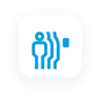Over the last decade, we have experienced a rapid upsurge in the use of robots across various industries. The grocery industry has experienced a similar trend for the last few years. Giant supermarket chains and e-tailers such as Walmart, Stop&Shop, Starship Technologies, and Amazon are increasingly experimenting with robots that are capable of walking down the sidewalks and delivering groceries at their customers' doorsteps.
From cleaning floors, stocking shelves to delivering groceries to shoppers, robots are now capable of handling several tasks at grocery outlets. Employing robots to perform day-to-day operations and repetitive tasks brings substantial benefits in terms of cost reduction and enhanced operational efficiency for businesses within the grocery industry.
Let's shed some light on the different types of robots used in grocery stores.
Self-Driven Cleaning Robots
Robots assisting with shopping are no longer fiction. You’ll find robots working alongside humans in many houses, stores, and offices today. Cleaning robots, for example, can move freely by scanning their surroundings, evading potential hazards, and looking for spills or dust on the floor.
There are even self-driven robots capable of cleaning themselves, while others can notify their human workmates. These robots can also perform additional tasks such as directing a customer or monitor the facility while transmitting camera footage in real-time.
Five hundred such robots are deployed at a Dutch grocery store Stop&Shop across America. These robots are responsible for notifying the store employees about any spilled or loose items on the aisles. As America’s largest retail service provider and private employer, Walmart announced in 2019 that it would employ 1,860 self-driving robots in more than 4,700 of its stores across the country.
Shelf-Scan and Inventory Robots
Inventory management is a critical process for grocery stores. Inconsistent tracking, manual documentation, and supply chain complexity hinder proper inventory management. Inventory robots are specifically made to carry out this task diligently.
These robots use technologies like machine learning and computer vision to scan and assess low stock or pricing mistakes. They can also automatically scan boxes as they come off delivery trucks to sort them by categories onto conveyor belts. Walmart plans to use 1,700 such robots across various outlets across America.
Delivery Robots
During the COVID-19 pandemic, robots also helped conduct contactless delivery operations. Moreover, by directly connecting customers with the robots through online portals, grocers could reduce clogged up aisles with customers. This new approach helped them save costly manual work and time as robots took care of systematically selecting, packing, and delivering groceries.
The robots can carry up to a certain amount of weight and travel independently to perform a contactless delivery. These robots functioned with an amalgamation of machine learning, artificial intelligence, sensors, and visual navigation, enabling them to move through sidewalks and avoid obstacles successfully.
Many retail companies started to utilize robots for delivery purposes. For instance, Save Mart, a Los Angeles-based company, has developed a system where robots get delivery instructions directly from their application. As a result, customers can order grocery items and get safe, quick, contactless, and convenient delivery straight to their doors.
The Importance of Sensors in Grocery Robots
Even though robots might have eased our earlier shopping conventions and experiences, a great amount of credit goes to sensors that enable robots to function with accuracy. From detecting obstacles and accessing the surroundings to scanning the products, robots need robust LiDAR sensors, safety laser scanners, and high-definition cameras to effectively perform all the autonomous operations.
These sensors must also ensure accurate data collection and transmission to ensure that these mobile robots perform the tasks with better accuracy, irrespective of the environment where they operate. For example, autonomous mobile robots such as automated guided vehicles (AGVs) require accurate distance information and a wide field of view to avoid any obstacles in their path. LiDAR sensors help robots provide this necessary information by using laser light pulses to measure the distance from the objects in real-time.
Sensors used for such mobile robotics applications must also consume less power as the entire system will rely on battery-operated platforms. Low-power consumption will help robots keep performing their tasks for a longer duration with the same level of accuracy. In addition, since these grocery robots are likely to move outdoors for delivery, sensors installed in these intelligent machines must continue operating accurately, even in all weather conditions.
Select the Right Sensor Technology for Your Grocery Robot
At Hokuyo-USA, we provide industrial-grade sensors for a range of indoor and outdoor autonomous robotics applications. Contact us to learn more about the sensor products we offer and how you can utilize them to build your next grocery robot.

 Factory Automation
Factory Automation Logistics Automation
Logistics Automation Process Automation
Process Automation Crane Collision Avoidance
Crane Collision Avoidance LiDAR/Obstacle Detection
LiDAR/Obstacle Detection Safety Laser Scanners
Safety Laser Scanners Optical Data Transmission
Optical Data Transmission Hot Metal Detectors
Hot Metal Detectors Laser Distance Sensor
Laser Distance Sensor Blog
Blog Whitepapers
Whitepapers Case Studies
Case Studies Infographics
Infographics